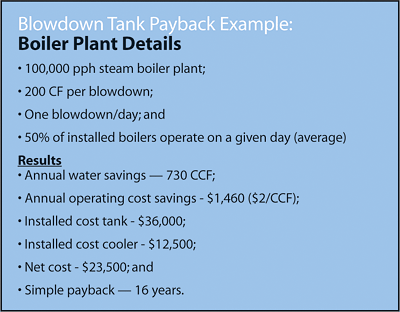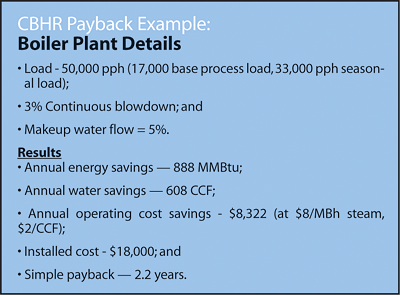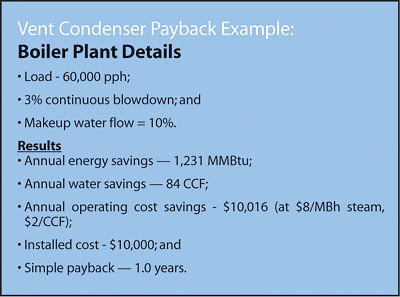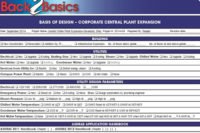
Sustainable Sites
Given the emissions, noise, and fuel storage associated with a typical central utility plant (CUP), it is particularly important to consider sustainable design issues in the siting of a central utility plant. Sustainable CUP design should incorporate the following strategies:
- Avoid sites on prime farmland, elevations less than 5 ft above 100 ft year flood plain, or sites within 100 ft of water or wetlands.
- Use a "brownfield" site, if practical.
- Consider the impact of emissions on adjacent buildings, use wind tunnel analysis to evaluate alternative sites and emissions technologies.
- Consider the noise impact of the CUP on adjacent buildings, locate away from residential areas.
- Route distribution piping through planned utility corridors, along streets, and existing pathways. Avoid disruption to undisturbed sites and vegetation.
- Locate the plant in proximity to the load, minimizing distribution energy and capital costs.
- Centralize fuel storage in a common location to serve generators, boilers, etc.
- Utilize sites that allow 100% of the liquid waste discharged from the building to flow by gravity (avoid pumped systems).
The plant should ideally be located with sensitivity to its neighbors. It should be located so that it is distant from and downwind of any critical air intakes. Wind tunnel analysis of the site is highly recommended to predict impacts of emissions on the local microclimate. Any adverse effects can be identified early and mitigated by alternative siting or application of design alternatives. The noise impact of the plant should also be evaluated, with particular emphasis placed on the distance from residential areas.

Water Efficiency
Most of the water used in a typical CUP is related to cooling tower operation. Here are a few notable methods for saving water.Cooling towers represent the largest water users in a typical plant. The combination of evaporation, blowdown, and drift at a cooling tower will result in 36 gpm of water lost per 1,000 tons of cooling (assuming three cycles of concentration and a 10°F condenser water ΔT). There are many ways to reduce or eliminate this water loss. One means is by the use of onsite water sources, such as collected rainwater, graywater, or subsoil drainage water (if available).
Alternative water treatment methods such as ozone treatment or pulsed magnetic technology will often allow an increase in the allowable cycles of concentration, thereby reducing the blowdown component of cooling tower water use. Alternative water treatment technologies offer the added benefit of either the reduction or complete elimination of chemical use.
One of the best ways to reduce cooling tower water consumption is to use an alternative method of heat rejection. The use of a heat sink completely eliminates the water loss associated with cooling tower use, and will typically reduce the energy consumption associated with heat rejection. Potential heat sinks include process cooling water loops, and heat pump cooling water loops, as well as innovative heat sinks such as sewer system heat exchangers or ground source loops.
On the heating side, the use of a bottom blowdown tank can eliminate the cooling water associated with the use of a bottom blowdown cooler. The tank will be considerably larger than the cooler, but will pay back over time, particularly if boiler blowdown is more frequent than once per day, or where water costs are high (Table 1).
Energy And Atmosphere
The four major sustainability categories under the energy and atmosphere heading are:- Optimize energy performance;
- Emissions reduction;
- Refrigerant selection; and
- Commissioning.
Let's start by looking at several options for optimizing energy performance before moving on to the other categories.

Energy-efficient Boilers
Firetube boilers, particularly three-pass and four-pass designs, can be 3% to 5% more efficient than industrial watertube boilers. If the higher pressure capability of a watertube boiler isn't necessary, consider firetube boilers. Firetubes most often yield a lower life-cycle cost than their watertube counterparts. Currently, most industrial watertube boilers just meet the code minimum 80% efficiency for gas-fired equipment. Firetube boilers are available with efficiencies as high as 85%.
The DOE launched its "Super Boiler Project" in 2000. The goal of the project is to leverage existing and emerging technologies to create a boiler that is 94% efficient while generating no more than 5 ppm NOx and 5 ppm CO2, by the year 2020. As this program advances, it is expected that commercially available boiler burner efficiencies will rise toward the target levels (and emissions levels will fall toward their 2020 target levels).
Waste Heat Recovery
The most common ways to recover waste heat from the steam generation process include: continuous blowdown heat recovery (CBHR), stack economizers, combustion air preheaters, and vent condensers.CBHR is one of the most common and cost-effective means of boiler heat recovery. The boiler's surface blowdown flow (typically 3% of the total flow) is used to preheat the makeup water to the boiler. Because this also results in cooling of the blowdown water to a temperature that can be handled by the drainage system, no aftercooler is required, resulting in cooling water savings (Table 2).
Stack economizers are another highly cost effective boiler heat recovery method. This is particularly true if one boiler is always used as the lead boiler, in that case, that boiler alone can be fitted with the stack economizer to maximize the payback potential (Table 3).
Combustion air preheaters (a.k.a. recuperators) are very similar to stack economizers in that they extract heat from the stack gas and use it to boost the effective boiler efficiency. Combustion air preheaters do this by preheating the combustion air via a stack-gas-to-air heat exchanger. This can be an air-to-air-heat exchanger or a runaround loop. Combustion air preheaters tend to take up more space and are generally less cost-effective than stack economizers.
Vent condensers are yet another means to recover waste heat, though on a smaller scale. A deaerator (DA) vent is a typical application for a vent condenser. A helical finned coil in a shell heat exchanger wraps around the vent and extracts heat that would otherwise vent to the atmosphere for use in preheating domestic hot water, reheat hot water, boiler makeup water, or other loads that can take advantage of the heat on a regular basis. A vent condenser provides the added benefit of condensate recovery and reduced makeup water consumption since the condensed steam falls back to the DA for reuse in the system.
Table 4 assumes that a 10 gpm flow of 50° makeup water to a DHW heater is preheated by the vent condenser on a 60,000 pph DA tank with a maximum steam flow of 5,600 pph at 5 psig. The calculation assumes the DA tank operates for only one-half of the year (4,380 hours annually). The calculation assumes vented steam to be 5% or 280 pph whenever the tank is in operation and that the steam condenses fully in the vent condenser (Table 4).

Variable-speed Boiler Combustion Air Blowers
Boiler blowers often produce excess pressure at part load conditions. As these blowers become larger due to reduced emissions requirements, the opportunities for energy savings using variable-speed drives on these blowers have increased. Good applications include boilers with long operating hours at part load, particularly loads below 50% fire.Oxygen Trim
Oxygen trim has been shown empirically to improve average annual boiler efficiency by 0.1% to 0.8%, dependent on boiler efficiency, by optimizing the fuel-air ratio based on the temperature, pressure, and humidity of the incoming air.
Combined Heat and Power (CHP)
The two most commonly used approaches to CHP include gas turbines with heat recovery steam generators (HRSGs) or high-pressure steam boilers with back-pressure turbines. Diesel engine and gas engine based CHP is also possible, but the waste heat from these devices cannot be used to generate high-pressure steam. Solid oxide and molten carbonate fuel cells are also capable of generating high-pressure steam, but fuel cell costs are still very high. The efficiencies and operating costs of several different CHP technologies are in Table 5.
Figure 1 illustrates the multiple points of energy loss in a typical scenario in which a building is served by a remote power plant with local standby capability. Figure 2 illustrates the avoided energy loss when heat and power are produced locally.
Alternative Chiller Technologies
Alternatives to electric centrifugal chillers include single- and double-effect steam absorption chillers, double-effect gas absorption chillers, gas-engine-driven centrifugal chillers, and steam turbine-driven centrifugal chillers. The economic coefficient of performance (ECOP) provides a means to compare the economic performance of these various technologies by building the variation in fuel price into the equation. Electric centrifugal chillers offer the best performance under most economic circumstances in most North American cities at this time. Steam turbine-driven chillers provide the best performance among the steam-fired chiller types, and gas engine chillers are the best performing among gas-based technologies.Table 6 evaluates chiller ECOP under a variety of utility rate scenarios. The number in bold in each column reflects the best economic performance under that particular utility rate scenario.
Steam-driven machines may still make economic sense for summer load balancing in CHP applications, despite their generally low ECOPs.

High-efficiency VFD-driven Chillers
VFD-driven chillers offer extremely low energy use at part load. A typical integrated part load value (IPLV) kW/ton for an efficient VFD-driven centrifugal chiller is in the 0.35 to 0.38 range, whereas a comparable constant-speed centrifugal machine's IPLV would likely be in the 0.49 to 0.52 kW/ton range.Chilled Water System ΔT
As chiller efficiencies continue to increase, pumping energy has become a larger component of the overall cost of operation of a chilled water plant, particularly at part load. Chilled water pumping energy can be reduced by optimization of the chilled water ΔT used in design of the system (which should generally be between 12° and 20°), as well as through the use of variable-speed pumping systems.Condenser water systems have traditionally been run at a 10° ΔT, but higher Δ will result in an overall reduction in consumption for most systems. A condenser water Δ of 12° to 18° is considered optimal for minimization of overall system energy use in typical systems.
Because condenser water loops are typically constant volume and traditionally use a low (10°) ΔT, their contribution to overall system energy use becomes very high at part-load conditions.

Variable-speed Pumping
Variable-speed pumping is very effective at reducing energy distribution costs in line with the reductions that are possible on the generation side. Primary-secondary and primary-secondary-tertiary chilled water pumping systems are very common and would be considered the current industry standard. Variable primary-only pumping systems are becoming more popular, however, because they can often offer additional energy savings, relative to a primary-secondary system, while also reducing first cost and maintenance cost due the elimination of a second set of pumps.
As other subsystems within a chilled water plant become more efficient, the condenser water end of the system has become more of a contributor to overall energy use, on a percentage basis. Variable flow condenser water systems will often offer relatively short payback periods, particularly where the condenser water ΔT is low, e.g., 10° to 12°. Condenser water flow rate turndown should be limited in order to maintain stable chiller operation and high tube velocity.
Emissions Reduction
As mentioned previously, the DOE launched its "Super Boiler Project" in 2000. The goal of the project is to leverage existing and emerging technologies to create a boiler that is 94% efficient while generating no more than 5 ppm NOx and 5 ppm CO2, by the year 2020.Gas-fired boilers are currently available with burners capable of NOx emission levels of 12 ppm as standard equipment. It is possible for most major manufacturers to meet 9 ppm NOx emissions levels or lower with additional modifications.
The cost premium for a 12 ppm NOx boiler relative to a 30 ppm NOx boiler is approximately $60/bhp in large boiler sizes. If we assume 2,500 equivalent full load hours of operation annually over a 25-year boiler life, the cost is $0.66/lb NOx emissions avoided over the life of the boiler, with a total 91 lbs NOx avoided per bhp.
Emissions levels for fuel oil-fired boilers are higher than those for gas-fired boilers. Treated biodiesel offers an alternative that can result in emissions levels low enough to allow extended operation of both boilers and emergency generators on diesel. The use of biodiesel results in significant reductions CO, unburned hydrocarbons, and particulate matter emissions, but a slight increase in NOx emissions, as shown in Table 7 from an October 2002 EPA study on biodiesel. The table indicates emission changes for 100% biodiesel relative to #2 fuel oil. When treated with a NOx reduction additive, NOx emissions can be also be reduced significantly.
Propane-air systems offer another alternative to diesel fuel backup for standby generators and boilers. Propane-air systems consist of liquid propane storage tank(s), a vaporizer, and an air blender. The blender yields a 45% propane / 55% air mixture that can be burned in natural gas burners and engines without modification. The energy density of liquid propane is approximately 65% of #2 fuel oil. Because of its reduced energy density and due to the need for the vaporizer and blender, the space requirements for installation are roughly double for a propane-air system relative to a fuel oil system.
A propane-air system opens up a number of new opportunities; for example, its use would allow a gas-turbine-based cogeneration system to be used as an standby power source. If a cogeneration system can double as an standby generator, then its net capital cost is reduced significantly (or possibly eliminated) due to the avoided cost of a diesel standby generator.
Consider two plant alternative designs for a plant with a 100,000 pph steam production capacity and 6 MW standby power generation capability: the first uses a conventional boiler plant and diesel standby generators, the alternative configuration includes a gas turbine, and a heat recovery steam generator (HRSG) with a supplemental fire and propane-air fuel backup system. Table 8 compares the costs for the two systems.
The propane-air system allows the gas turbine to be used as a standby power source, independent from external utilities, and its first cost is reduced by the elimination of the need for diesel generators. The system has the benefits of both the high fuel conversion efficiency of a CHP system (up to 80%), as well as elimination of the diesel engine emissions.
Refrigerant Selection
Currently, to achieve Energy and Atmosphere Credit #4 (EAc4), a facility must be free of HCFC's and Halons. R-123 is an HCFC and its use would disqualify the project from achieving this credit; R-134a is the only commonly available refrigerant for large centrifugal chillers that meets this requirement. A potential change to EAc4 is included in public review version 2.2 of the LEED rating system. The proposed change to the rating system would allow both R-123 and R-134a, recognizing that while although R-123 does have a small ozone depletion potential (its ODP is 0.014 relative to R-134a's ODP of 0.00), its global warming potential of 90 is much lower than R-134a's GWP of 1,300.Commissioning
Commissioning of a central plant is particularly important, given the relatively high flows of energy generated in the plant. In order to achieve the Energy and Atmosphere Credit #3 (EAc3) for additional commissioning under the LEED rating system, an independent commissioning agent must be appointed during schematic design phase of a project. The independent agent reviews the project at schematic design phase and construction document phase, performs full building commissioning following construction of the building, provides the owner with a recommissioning manual, and follows up with the O&M staff 10 months following substantial completion of the project.Materials And Resources
Materials and equipment should be selected based on their energy performance, life expectancy, health-related impacts, and environmental impacts. A qualitative insulation material evaluation matrix is shown in Figure 5. This can be used to screen for allowable materials, with a more quantitative analysis of materials that survive the qualitative review.Indoor Environmental Quality
Air intakes serving occupied areas of a central plant should be located away from cooling tower discharge plumes and boiler and emergency generator exhaust stacks.
It is highly recommended that a wind tunnel analysis be performed to review any potential impacts of the plant on air intakes and windows in adjacent buildings, as described in the sustainable sites section.
Innovation And Design Process
Deep water cooling.Deep water cooling systems involve large deep bodies of water with year-round temperatures between 39° and 45°. In a typical system, water is drawn to a pumping station near the surface where it is run through a heat exchanger, and is then re-injected. The cooling water on the other side of the heat exchanger can be used directly for cooling, or in some cases undergoes some supplemental cooling in a chiller before use in buildings.Deep water cooling systems in operation today have typically produced operating cost savings of 85% to 90% relative to conventional chilled water plants.
The list of cities using this technology is growing rapidly. Stockholm; Honolulu; Toronto; Vancouver; San Francisco; Ithaca, New York (Cornell); and Seattle are among the cities either using this technology or studying its use.
Alternative heat sources and sinks. European manufacturers have developed heat exchangers that can be used as inserts into existing sewer pipes. The inserts are placed in the bottom of the sewer pipe and a heat transfer medium is circulated through channels built into the inserts. Sewers can be excellent heat sources for residential and light commercial heating, particularly where the sanitary sewer flow is not mixed with stormwater flow.
The use of ground source wells or ground loop piping can be used to create a heat sink or source for use by water-cooled heat pumps or as a heat sink for chillers. In some cases, groundwater may be capable of meeting a significant portion of a building's cooling demand.
Conclusions
Many sustainable design opportunities exist for central utility plants, ranging in scope from relatively small items (vent condensers) to very large-scale concepts (deep water cooling). Sustainable central plant design can have a very large impact on the overall sustainability of a campus or utility district due to the high level of resources consumed and exported by the plant.The development of new central utility plants and the renovation of existing plants offer unique opportunities for sustainable design. Sustainable site selection is particularly important, due to the impacts of emissions, noise, and the disruption associated with tunnels radiating from the plant.
Due to the energy intensity of the central plant, many sustainable design features focus on energy conservation. These energy conservation measures include efficient primary generation equipment, waste heat recovery devices, and efficient distribution systems, as well as optimized design parameters. Many of these measures have a payback of less than two years.ES
Bibliography
Environmental Protection Agency. " Comprehensive Analysis of Biodiesel Impacts on Exhaust Emissions: Draft Technical Report." USEPA 420-P-02-001, October 2002.
Environmental Protection Agency. "Introduction To CHP Technologies." October 2001.

